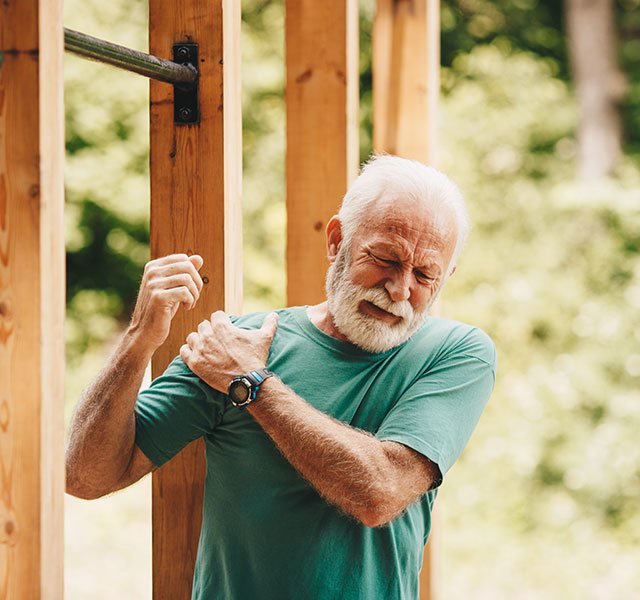If you have arthritis, summer heat and humidity can increase your joint pain and make daily activities a challenge. Many people who have arthritis feel more discomfort as the weather changes throughout the year. But there are steps you can take to manage your symptoms and stay active.
“It is very common for people with arthritis to experience more pain and swelling as weather patterns shift,” Trevor North, M.D., an orthopedic surgeon at Henry Ford Health. “However, that doesn’t mean you have to stop enjoying your favorite activities. By eating healthy foods, choosing low-impact exercise and using a walking aid, you can control your arthritis symptoms.”
What Is Arthritis And Who Is At Risk?
Arthritis occurs when the cartilage, which serves as a cushion between the bones in your joints, wears down. There are many types of arthritis, including rheumatoid arthritis, osteoarthritis and psoriatic arthritis. According to Dr. North, as any of these conditions progress, joints become inflamed, causing pain, swelling and stiffness.
There are many factors that increase your risk for developing arthritis, including:
- Age: As you age, your risk for developing arthritis increases. In fact, most people over 55 have some deteriorated cartilage, and half of them experience arthritic symptoms.
- Genetics: Certain inherited characteristics, such as the shape of your bones and the composition of the cartilage between your bones, can affect your risk for developing arthritis. For example, if bones in your thigh and leg are slightly out of alignment, this can place greater pressure on your knee and ankle joints. Some people also have softer cartilage that wears down faster over time.
- Weight: As you move, your body weight places pressure on your joints. As you gain weight, the wear and tear on your joints increases. For example, when you walk up steps, the pressure placed on your joints is equal to 5 times your body weight. If you gain 10 pounds, you place 50 pounds more pressure on your joints.
- Injuries: Once you’ve injured one of your joints, you have an increased risk of developing arthritis in that area. For example, a wrist injury increases your risk for arthritis as well as other conditions.
Why Does Joint Pain Increase As Weather Patterns Change?
While temperature fluctuations can affect arthritis symptoms, Dr. North says there is significant evidence that changes in barometric pressure actually have a greater impact on joint pain and swelling.
“Your joints have pressure receptors. When there is a low-pressure system that brings rain or higher humidity, you are more likely to see your arthritis symptoms worsen,” explains Dr. North.
5 Steps To Manage Arthritis Pain
When you have arthritis pain, it is important to learn ways to safely keep moving and reduce your symptoms.
Dr. North suggests these steps to manage joint inflammation (and other types of joint pain):
1. Eat a healthy diet. Maintain a healthy weight and reduce inflammation by eating:
- High-fiber foods, like brown rice, whole grain pasta and oatmeal
- Green leafy vegetables such as spinach and broccoli
- Fruits, nuts and berries
- Lean protein such as fish or seafood
- Low-fat dairy products
2. Avoid foods that could cause more inflammation. Stay away from foods that are high in saturated fats, including processed foods, fried foods and full-fat dairy products.
3. Stay hydrated. Drinking water is the best way to stay hydrated throughout the day. Ask your doctor how much water you need for optimal health.
4. Choose low-impact exercises. Walking, biking and swimming are all low-impact exercises that will keep you moving and minimize pressure on your joints. Avoid running, jumping or contact sports. Can’t get outside on a rainy day? Use a stationary bike or treadmill to stay active.
5. Avoid smoking and alcohol consumption. Alcoholic drinks and smoking can increase joint inflammation.
When To See A Doctor About Joint Pain
“If you are unable to perform daily living tasks or the activities you enjoy, see your primary care physician or an orthopedic specialist,” says Dr. North.
Treatment options to relieve arthritis pain include:
- Physical therapy to strengthen the muscles surrounding the arthritic joints
- Over-the-counter anti-inflammatory medications
- Injections of anti-inflammatory medications for longer-lasting pain relief
- Ambulatory aids, such as a cane or walking stick, to relieve pressure on affected joints
To find a primary care or orthopedic specialist at Henry Ford, visit henryford.com or call 1-800-436-7936.
Dr. Trevor North is an orthopedic surgeon who sees patients at Henry Ford Hospital in Detroit, Henry Ford Medical Center - Lakeside in Sterling Heights, and Henry Ford Medical Center - Cottage in Grosse Pointe Farms.



